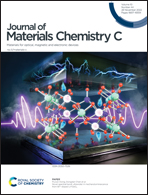Impact of crystal growth diversity on magneto-photoluminescence and circular dichroism in chiral lead halide perovskites†
Abstract
Chiral-induced magneto-photoluminescence (magneto-PL) is a newly raised magneto-optical phenomenon, where photoluminescence intensity can be effectively manipulated by magnetic fields and material helicity. By far, little is known regarding the impact of crystallographic orientations on chiral-induced magneto-PL and circular dichroism (CD) for solution-made polycrystalline chiral lead halide perovskites (LHPs). By tuning weight percentages (wt%) rationally for precursor solutions in the work, we found that large magneto-PL (−13.2%) with strong tunability via polarized photoexcitation is highly decided by the crystallographic orientations for the chiral LHPs. The large effect stems from the effectiveness of magnetic field modulation to excitonic fine structures. We also found that diploe-allowed excitonic transitions and the CD characters could be dramatically influenced by crystallinities. Thus, a full understanding of its growth mode and optical properties is of paramount importance for achieving large magneto-PL with strong tunability. The work opens a new avenue for chiroptical applications.

- This article is part of the themed collection: Circularly Polarised Luminescence


 Please wait while we load your content...
Please wait while we load your content...